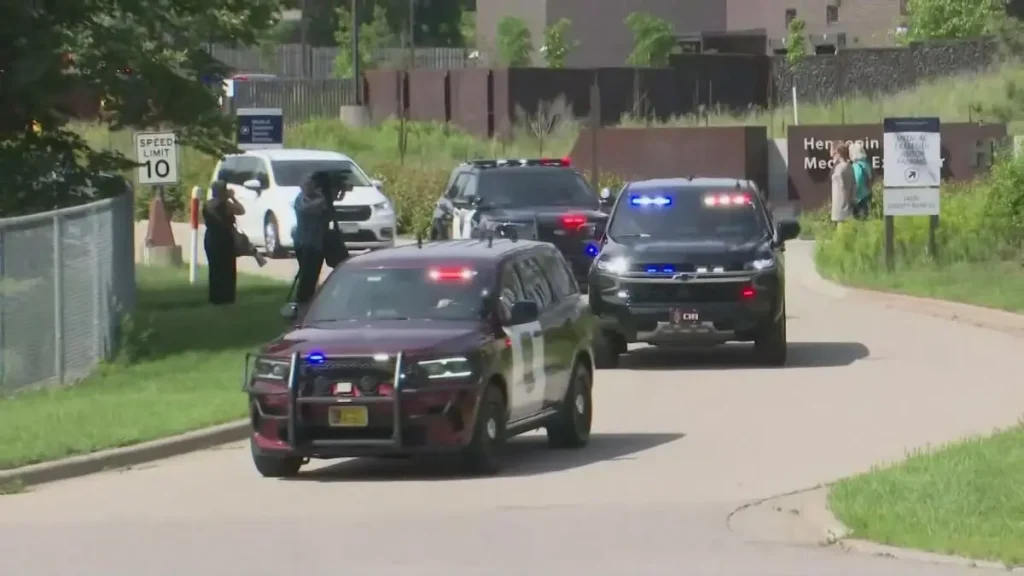Slain Minnesota Lawmaker’s Home Targeted in Break-in, Sparking New Security Concerns
On June 18, 2025, the quiet community of Brooklyn Park, Minnesota, became the scene of an unsettling event: a break-in at the home of Minnesota Rep. Melissa Hortman. This wasn’t just any burglary. It happened at the home of a lawmaker who had been tragically killed just days earlier. The emotional shockwave from the break-in is still rippling through Minnesota.
What makes this incident stand out is not just the crime itself, but the fact that it targeted a public figure’s home. A lawmaker’s home. In the wake of Hortman’s death, which had already shaken the state, this burglary raises serious questions about the security of our political leaders. And it leaves us all wondering: How safe are those who are tasked with representing us?
I’m sure you’re asking, how does this break-in reflect the broader concerns about personal security for politicians, especially in such volatile times? The incident is a stark reminder of how vulnerable public figures can be—even in their most private spaces. The news reports focus on the investigation, and yet, there’s a much bigger question lurking: What does this say about our society’s commitment to ensuring the safety of those in power?
The break-in at Rep. Hortman’s home goes beyond just a criminal act. It’s a wake-up call that we, as a society, may need to rethink the level of protection we provide to those who stand at the forefront of our political landscape.
Stay with me here, because what happened next could have a ripple effect on security policies nationwide.
A Closer Look at Rep. Melissa Hortman’s Life and Political Legacy
Before the tragic events that unfolded, Rep. Melissa Hortman was known for her resilience, her commitment to public service, and her dedication to the people of Minnesota. She had served as the Speaker of the Minnesota House of Representatives, shaping policies that impacted everything from healthcare to education.
Hortman’s legacy isn’t just about laws she passed or political battles she fought. It’s about the values she represented—integrity, fairness, and a deep-rooted desire to make Minnesota a better place for all. Her death left a profound void not only in the political world but also in the hearts of her constituents.
Now, with this break-in at her home, there’s an added layer of pain for those who admired her work. It’s a reminder of how public figures, even those fighting for justice and equality, are vulnerable to forces beyond their control. This tragedy will undoubtedly shape how we remember her, but it also raises questions about the larger picture of political security.
How Does This Break-In Affect Public and Political Safety?
In the wake of the break-in at Rep. Hortman’s home, a key question arises: How safe are political figures today? The answer isn’t as simple as it seems. The break-in highlights the vulnerability of lawmakers to personal security threats—something we don’t often think about when we go about our daily lives.
Politicians, like any public figure, live under constant scrutiny. Their every move, every word, can be dissected and criticized. But now, it’s clear: their safety is just as much at risk as their careers. The break-in serves as a glaring reminder that no one is immune from intrusion, even when they’re supposed to be protected.
Security measures around politicians, especially those in high-profile positions, are often seen as a given. But clearly, as this incident shows, gaps in those measures can leave public figures exposed. Whether it’s a break-in, a stalker, or other threats, the safety of our lawmakers needs to be a priority.
What do you think about the safety of public figures in today’s climate? Share your thoughts in the comments below—we’d love to hear your perspective on this critical issue.
The Investigation Unfolds: What We Know So Far

As of now, local authorities are diligently working to uncover the details surrounding the break-in at Rep. Hortman’s home. According to CNBC reports, the break-in occurred when the house was unoccupied, and there’s no indication yet of foul play involving anyone connected to the lawmaker’s personal life.
Law enforcement agencies have assured the public that they are working swiftly to identify suspects and bring those responsible to justice.
While the investigation is ongoing, it has already prompted a deeper conversation about the level of security provided to lawmakers. Could this incident lead to better protection for political figures? Only time will tell. But one thing is certain: the community is deeply shaken by this breach, and many are left asking why there wasn’t better protection for someone who played such a pivotal role in the state’s leadership.
Similar break-ins and home invasions have occurred across the country, highlighting a disturbing trend in rising criminal activity. For example, the armed home invasion in Miami Beach left a victim severely injured and raises concerns about security for all homeowners.
Expert Opinions: How Can Lawmaker Security Be Improved?
Security experts agree: This break-in is not an isolated incident. Lawmakers, especially those in prominent roles, are more vulnerable than ever. And unfortunately, as history has shown, public figures have often become targets of crime, whether for political reasons or personal vendettas.
In response to these types of security breaches, experts recommend a more comprehensive security protocol for political leaders. This might include everything from enhanced home security systems to the use of private security personnel for personal protection. Additionally, lawmakers should receive regular security training, particularly in how to handle threats or potential break-ins.
According to former FBI agent and security consultant, John Smith, “Public figures need to treat their safety as seriously as they treat their public appearances. That means better home security, better crisis management plans, and ensuring law enforcement is always on alert.”
As this conversation unfolds, expect the conversation around personal safety for public figures to intensify. The importance of proactive security measures is now clearer than ever before.
Security experts emphasize the importance of proactive safety measures. If you’re interested in more insights and updates on lawmaker security and home safety, consider joining discussions in WhatsApp group and Facebook groups for real-time advice and updates from experts.
The Emotional Impact: How This Break-In Affects Minnesota’s Communities
For the residents of Minnesota, the break-in at Rep. Hortman’s home has left more than just a sense of fear—it has left a deep emotional scar. This was not just an attack on a home; it was an attack on the sense of security that people have in their leaders.
When tragedy strikes, we often expect to rally around those affected. But what happens when that tragedy leads to even more distress and fear? Minnesota is now grappling with the emotional fallout of this break-in. It’s not just about safety anymore; it’s about the broader impact on the community’s sense of trust in their leaders and in the systems that protect them.
As a state, we’ve been shaken. But this incident may also lead to an important shift in how we view safety—not just for political figures, but for everyone. The break-in has forced us to confront our assumptions about security, and in doing so, it’s sparked a larger conversation that can no longer be ignored.
The next steps are crucial—not just for the safety of politicians, but for the emotional well-being of the communities they serve.
The emotional impact of such break-ins is profound, not just on the victims but also on entire communities. In Horry County, multiple armed robberies and home invasions led to a wave of fear that swept through local neighborhoods. For more on the emotional toll these crimes take, check out our coverage of similar incidents.
What Are the Broader Political Ramifications for Minnesota?
The break-in at Rep. Melissa Hortman’s home isn’t just a personal tragedy for her family; it has the potential to reverberate throughout Minnesota’s political landscape. This incident could trigger significant changes in the way public figures are protected and how political security is viewed across the state.
One immediate impact could be the re-evaluation of security measures for state lawmakers and government officials. With this event exposing gaps in personal safety for politicians, lawmakers may push for more stringent security protocols to prevent similar incidents in the future.
This could mean heightened budgets for security services, better surveillance systems, and, in some cases, private security details.
Moreover, this break-in could spark legislative conversations about the emotional toll that such incidents take on public figures. The safety of those in power might become a focal point for both Democrats and Republicans as they seek to protect not only their physical well-being but also their mental health in the face of constant threats.
The break-in could lead to changes in policy that prioritize both the physical and emotional security of lawmakers—something we haven’t seen on such a scale before.
This tragic break-in reminds us that even minor security lapses can have severe consequences. In Plainfield, a woman was arrested for assault and home invasion using brass knuckles, a stark reminder of the types of crimes that can result from inadequate home security.
What Can We Learn from This Tragic Event?

The break-in at Rep. Hortman’s home serves as a harsh reminder that political figures are often vulnerable, both in their personal and professional lives. For the public, it raises awareness of the need to treat safety for politicians with the same level of seriousness as any other form of public protection.
First, we can learn that security protocols for public figures must evolve. Whether it’s through better surveillance, private security, or improved crisis management, there’s no denying that we need to be more proactive about safeguarding those who represent us.
Second, we learn that emotional and psychological well-being should be part of the conversation on political safety. A break-in like this affects more than just the physical security of a home; it rattles the emotional core of a leader and their family. As a society, we must consider the mental and emotional toll these threats take on our leaders.
Lastly, this tragic event teaches us that political safety isn’t just about preventing criminal acts; it’s about maintaining a sense of peace, trust, and stability in the political process. This break-in has exposed an uncomfortable reality, but it has also prompted a necessary discussion that could lead to meaningful change in the future.
Final Thoughts
As we process the events surrounding the break-in at Rep. Hortman’s home, we must acknowledge the larger question at play: How do we ensure the safety of our public figures in an increasingly polarized and threatening world?
The tragedy underscores the vulnerability of those who hold public office and, perhaps more importantly, the urgent need for a society-wide conversation about security. Lawmakers, politicians, and government officials must feel safe in their homes, just like the rest of us.
But this won’t happen unless we take a closer look at the systems in place to protect them—and if necessary, overhaul them to prevent further breaches of safety.
As citizens, we must also remember that the safety of our leaders is intertwined with the well-being of our communities. A safe and secure environment for politicians often translates into a safer environment for everyone. The security measures we put in place today could be the foundation of a more secure tomorrow for all public figures, from local representatives to national leaders.
This break-in has sparked critical discussions about the safety of political leaders and the emotional toll on communities. To explore more on this topic, visit our website for related articles and updates.
Disclaimer: The views and opinions expressed in this article are those of the author and do not necessarily reflect the official stance of any organization or entity. All information presented is based on current events and publicly available sources. Readers are encouraged to verify any facts or claims independently.


